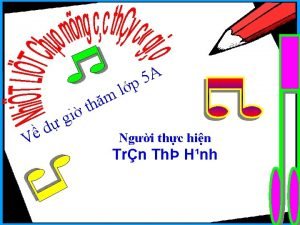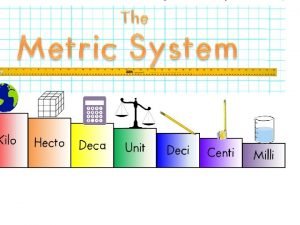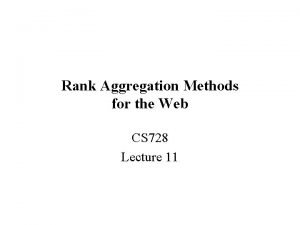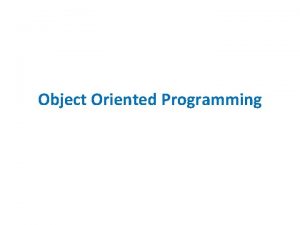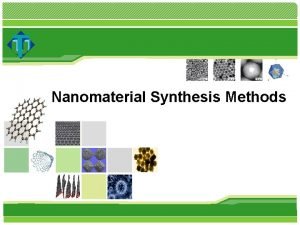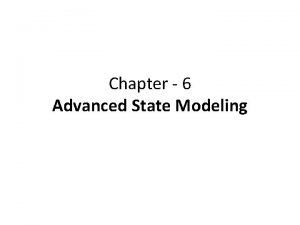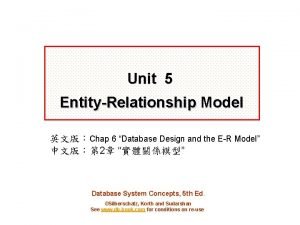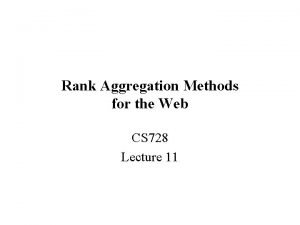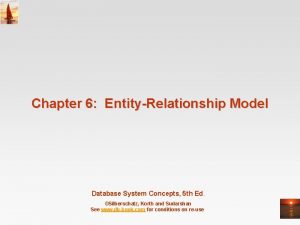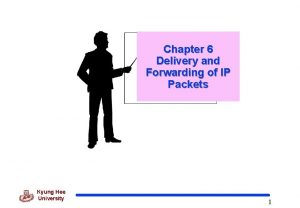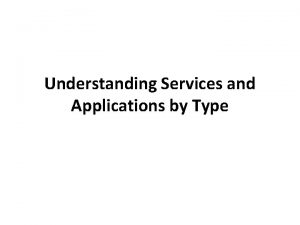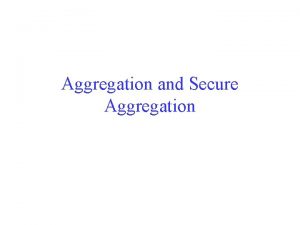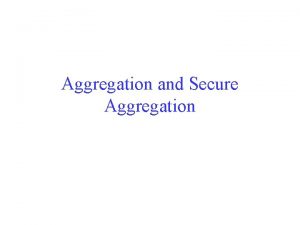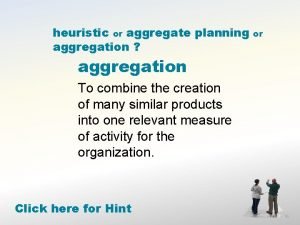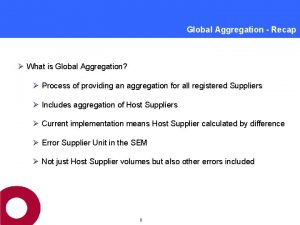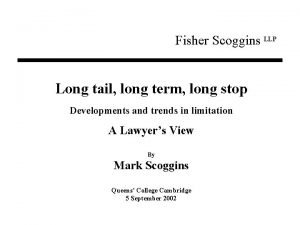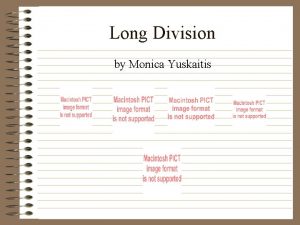Online Aggregation 2011 4 15 Liu Long Aggregation






































- Slides: 38

Online Aggregation 2011 -4 -15 Liu Long

Aggregation • Operations related to aggregating data in DBMS – AVG – SUM – COUNT

An Example Select AVG(grade) from ENROLL; • A “fancy” interface: Query Results + AVG 3. 262574342

A Better Approach • Don’t process in batch! Online aggregation: represent the final result

Content • Question & Motivation • The Approach – Goals – Implementation – Evaluation • Summary & Future Work

Content • Question & Motivation • The Approach – Goals – Implementation – Evaluation • Summary & Future Work

Ideal Approach Select AVG(grade) from ENROLL GROUP BY major;

Goals & Requirements • Continuous output – Non-blocking query plans • Time/precision control • Fairness/partiality

Content • Question & Motivation • The Approach – Goals – Implementation – Evaluation A Naïve Approach Modify the database engine • Summary & Future Work

A Naïve Approach SELECT running_avg(grade), running_confidence(grade), running_interval(grade), FROM ENROLL;

A Naïve Approach • Drawbacks: – No grouping – No guarantee of continuous output – No guarantee of fairness (or control over partiality)

1. Random Access to Data • Heap Scan – OK if clustering uncorrelated to agg & grouping attrs • Index Scan – can scan an index on attrs uncorrelated to agg or grouping • Sampling: – could introduce new sampling access methods (e. g. Olken’s work 93’)

User Interface

2. Group By & Distinct • Fair, Non-Blocking Group By/Distinct – Can’t sort! • sorting blocks • sorting is unfair – Must use hash-based techniques – Hybrid hashing(84)! • especially for duplicate elimination. – “Hybrid Cache” (96) even better. • Memorization • sorting

User Interface

3. Index Striding • For fair Group By: – want random tuple from Group 1, random tuple from Group 2, . . . – Sol’n: one access method opens many cursors in index, one per group. Fetch round-robin. – Can control speed by weighting the schedule

User Interface

4. Join Algorithms • Non-Blocking Joins Algorithms Acceptable Notice Sort-Merge join _ Merge join Chosen with care because of the sorted output Hybrid hash join(84) Acceptable if the inner relation is small Pipeline hash join(91) Non-blocking join but less efficient(completion time) Nested-loops join(96) Stable, but unacceptable for its unindexed inner relation

5. Query Optimization • Entirely avoid sorting in an online aggregation system • Extend “Interesting Orders”(79) to online aggregation • User control vs. performance? – Running multiple versions of a query(Rdb, 96)

6. Aggregate Functions • Add a 4 th aggregate function – SUM, COUNT, AVG • Use the formulae provided in the Appendix • Extended aggs need to return running confidence intervals

7. API • Current API uses built-in methods – Three basic functions: • speedup. Group, slow. Down. Group, stop. Group • e. g. select Stop. Group(val) • Very flexible. Easy to code – The fourth function: • set. Skip. Factor(val, int)

User Interface • Inter-tuple speed is critical!!

8. Statistical Issues • Confidence Intervals for SQL aggs – given an estimate, probability p that we’re within e of the right answer • 3 types of estimates Conservative (Hoeffding’s inequality) Large-Sample (Central Limit Theorems) Deterministic Previous work + new results from Peter Haas

Conservative confidence interval • Based on Hoeffding’s inequality • Valid for all

Large-Sample confidence interval • Based on central limit theorems(CLT) • Appropriate when n is small enough

Deterministic confidence interval • With probability 1 • Useful only when n is very large

Appendix: formulae

Content • Question & Motivation • The Approach – Goals – Implementation – Evaluation • Summary & Future Work

Evaluation • Testbed – prototype in Postgres 95 – 96 MB main memoty – 1 GB disk • Dataset – University of Wisconsin – Single table – 1, 547, 606 rows, about 316. 6 MB

Pacing study Select AVG(grade), Interval(0. 99) From ENROLL; Traditional plan

Access Methods, Big Group Select AVG(grade), Interval(0. 95) From ENROLL GROUP BY college; College L: 925 K tuples

Access Methods, Small Group Select AVG(grade), Interval(0. 95) From ENROLL GROUP BY college; Surprise! College S: 15 K tuples

Content • Question & Motivation • The Approach – Goals – Implementation – Evaluation • Summary & Future Work

Summary • A new approach to aggregation! – Implementation of a RDBMS engine – Continuous output – Hash-based group by – Duplicate elimination – Index striding – New APIs – User Interface

Future Work • Better UI – online data visualization • graphical aggregate • great for panning, zooming • Checkpointing/continuation – also continuous data streams • Extension of statistical results: – simultaneous confidence intervals

What makes it outstanding ? • Leading a new subject • Applicable to practical problems • Sufficient and broad analysis – Join algorithms – Various statistical estimation theories • Implementation with real system • A little bit luck

Online Aggregation With MR • • Progress Estimation Multi-job Map. Reduce Statistical model for Map. Reduce Join Algorithms

Thank you! 2011 -4 -15 Liu Long
 Alex liu cecilia liu
Alex liu cecilia liu Líu líu lo lo ta ca hát say sưa
Líu líu lo lo ta ca hát say sưa Tall + short h
Tall + short h Once upon a time there lived a little country girl
Once upon a time there lived a little country girl Not so long ago, people
Not so long ago, people There lived
There lived Tinikling costume and props
Tinikling costume and props Once upon a time long long ago
Once upon a time long long ago Long long int c
Long long int c Greek
Greek Sóc nhí câu đố
Sóc nhí câu đố Once upon a time a long long time ago begins the story
Once upon a time a long long time ago begins the story để nguyên nước chấm cổ truyền
để nguyên nước chấm cổ truyền Analysis class diagram example
Analysis class diagram example Uml private public
Uml private public Difference aggregation and composition
Difference aggregation and composition Capacity aggregation supply chain
Capacity aggregation supply chain Resource aggregation
Resource aggregation Rank aggregation methods for the web
Rank aggregation methods for the web Wan aggregation
Wan aggregation Aggregation in oop
Aggregation in oop Agglomeration vs aggregation
Agglomeration vs aggregation Microservices data aggregation
Microservices data aggregation Advanced state
Advanced state Bgp route aggregation
Bgp route aggregation An aggregation relationship is usually represented as
An aggregation relationship is usually represented as Remote sensing
Remote sensing Er model arrows
Er model arrows Rank aggregation methods for the web
Rank aggregation methods for the web Mr stepek
Mr stepek Aggregation database
Aggregation database Address aggregation simplifies the forwarding process in
Address aggregation simplifies the forwarding process in Choropleth map example ap human geography
Choropleth map example ap human geography Foo9822
Foo9822 Pods aggregation and silos in cloud computing
Pods aggregation and silos in cloud computing Resource and cost planning
Resource and cost planning Platelet aggregation test
Platelet aggregation test In seconds
In seconds Stepek ap human geo
Stepek ap human geo

